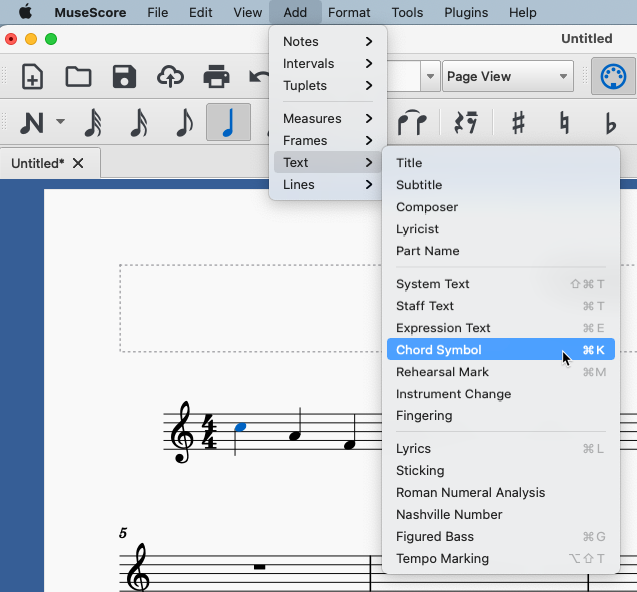Project 7 Table of Contents
Project 7: Overview – Chord Notation (Leadsheets)
In this project, we will learn about creating Leadsheets. Often used in popular music and jazz, a lead sheet provides minimal musical information in an attempt to be concise and present only the essential aspects of a song. This typically includes three parts:
- melody
- lyrics
- harmony via chord symbols
Summary: Building upon the 32 Bar Form, create a lead sheet that has a melody with chord symbols and OPTIONAL lyrics.
Features of this MuseScore document project include:
- 32 Bar Form (AABA)
- Traditional Chord symbols entered as letter name chords (for example, C7 or Dm)
- The chords should play during playback
- Melody needs to fit with the chord progression
- OPTIONAL: lyrics
- Title and your name as composer
How To… Project 7
Leadsheet chords are entered in MuseScore via the Add menu:

For a major chord, simply type the letter (Bb for B-flat chord, d for D major chord, and so forth). You’ll then use either the “spacebar” to move to the next note, “;” to the next beat, or “tab” to the next bar. See the listing below…
Entering Chord Symbols…
Enter a chord symbol
- Select a start note or a slash;
- Press Ctrl+K (Mac: Cmd+K);
- The cursor is now positioned above the staff ready for input. Enter the chord symbol just like normal text, as follows:
- Root note: A, B, C, D, E, F, G.
- Sharp: # (hash symbol).
- Flat: b (small letter “b”).
- Double sharp: x (small letter “x”) or ## (two hash symbols).
- Double flat: bb (small letter “b” twice).
- Natural: natural. Note: There should be no space before the word “natural”, but any chord text following it should be separated by a space—the latter inserted using the command Ctrl+Space. Thus, to write B♮m: enter “Bnatural”, then pressCtrl+Space, then type “m”. You can also use Ctrl+Shift+H. Note that neither of these transpose or play back (other than the root note), or export to MusicXML properly.
- For other symbols, see Chord symbol syntax (MuseScore Handbook Link).
- Move the cursor forward or backwards to continue entering or editing chord symbols as follows:
- Space move Cursor to next note, rest, or beat
- Shift+Space move cursor to previous note, rest, or beat
- Ctrl+Space (Mac: Alt+Space) add a space to the chord name
- ; move cursor to next beat
- : move cursor to previous beat
- Tab move cursor to next measure
- Shift+Tab move cursor to previous measure
- Ctrl (Mac: Cmd) plus number (1 – 9) move Cursor by duration corresponding to number (e.g.; half note for 6)
- Esc exit.
- (see Keyboard commands MuseScore Handbook Link);
- Exit chord symbol mode by pressing Esc.
When you exit a chord symbol, the characters entered will automatically assume the correct format: by default a root note typed in lower case will turn into upper case (for alternative options, see Automatic Capitalization); a “#“, “b” or “natural” will turn into a proper sharp (♯), flat (♭) or natural (♮) and so on. Do not try to use actual flat, sharp and natural signs, as MuseScore will not understand those properly.
Here’s a demo from me on using the Traditional Chord entry method as well as the “Nashville” system.
Project 7: Practice Sessions
Practice Sessions
As you work with entering chords, there are various “types” of chords such as:
| Type of Chord | Example |
| Major Chord | C |
| Minor Chord | Cm |
| 7th Chord | C7 |
| Chord over a specific bass. note | C/E |
And so here is a short video demonstrating how MuseScore displays and plays these various chords:

